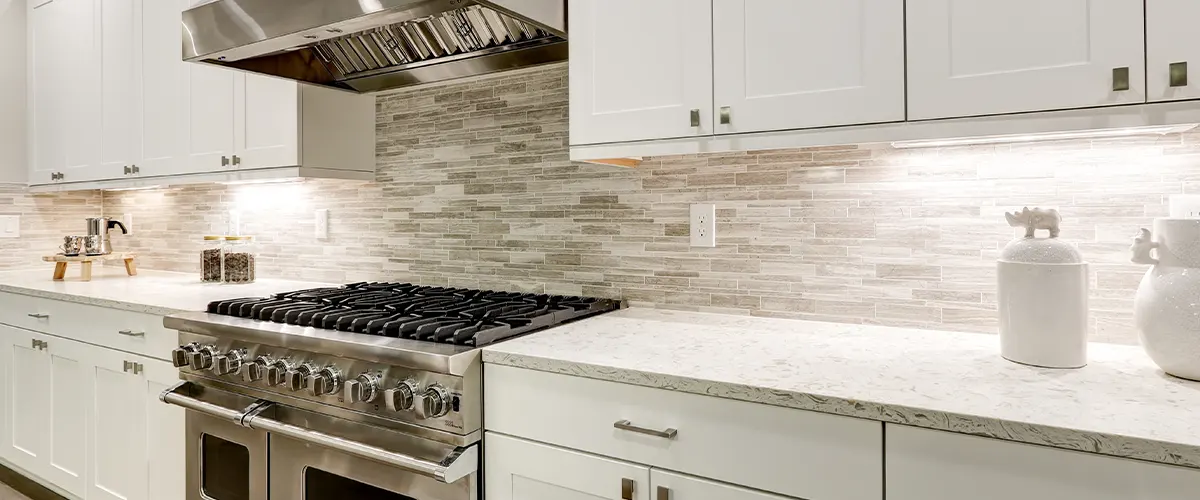A kitchen range might not change your kitchen’s interior design as much as cabinets do, but it will ensure your cooking experience is 10x better.
A kitchen range is a crucial piece of equipment in any kitchen, and it’s important to choose the right one for your needs. They come with many features and in many different sizes, so finding the perfect one for you could prove difficult.
This guide walks you through different types of ranges so you can make an informed decision when it’s time to buy. We’ll discuss features to look for when shopping for a range and various prices.
Read on, and let’s see how to choose the perfect kitchen range.

What Is A Kitchen Range
A freestanding range is a multifunctional kitchen appliance that combines a stovetop and an oven. Most homeowners frequently refer to a kitchen range as an oven, stove, cooktop, or cooking range.
However, it’s good to remember that a kitchen range is, in fact, the entire setup.
Oven
Stovetop

Gas vs. Electric Kitchen Ranges
In addition to the parts, a kitchen range also has different heating methods.
Many ranges come standard as either fueled by gas (propane or natural) or electricity.
But there is another option that many – especially professionals chefs and bakers- seem to favor.
Gas
Ranges fueled by gas warm quickly and allow precise temperature control and adjustment whenever necessary. Although not great for baking, the gas-fueled range is excellent for more seasoned cooks.
A professional gas range tends to be more expensive than its counterparts, the electric ranges, but you’ll save money on your energy bill.
However, make sure your home already has a natural gas supply line. Otherwise, the installation can be quite hefty.
Another disadvantage of the gas-fueled range is that you can have gas leaks in your home, which are harmful and dangerous. A gas cooktop needs to be constantly looked for and checked periodically. The best gas range will have a gas alarm installed for increased safety.
Electric
Ranges powered by electricity are easy to install and operate. The stovetop surface of an electric range is smooth, which means very little maintenance work to keep it clean.
Although electric ranges heat up slower than gas ranges, they provide heat consistency in the oven cavity which is great for avid bakers.
While an electric oven can cost more because of its energy usage, the appliance itself is less expensive than a gas range. Besides, electric ranges cost less to install since you don’t need to install the gas line.
However, if you live in an area where power outages represent a problem, keep in mind that you’ll not be able to use an electric range without power.
Dual-Fuel
You can get more flexibility by choosing a kitchen range model with a dual-fuel option. Depending on your cooking style, a dual-fueled range will improve your cooking performance by combining the benefits of the other options.
You’ll have accurate control of the temperature with a gas-fueled top and the constant heat of an electric-fueled oven.
These are high-end ranges ideal for devoted bakers and chefs who are willing to pay higher prices for more control over their cooking.

Kitchen Ranges With Smart Features
A new range can have a lot of reliable extra features that increase its value.
The best ranges have true convection mode, a convection fan, a self-cleaning feature, a temperature probe, a warming dishes option, an air fry, and even a storage drawer to keep big utensils like frying pans.
Other features include slide-in ranges, increased oven capacity, five sealed burners, or a larger top space.
Stainless Steel vs. Porcelain
Stainless Steel Kitchen Range
Stainless steel ranges can face every job at hand. Your stainless steel kitchen range is strong, durable, and never rusts.
All you need to do to make this material shine is wipe it down now and then to keep it clean and bacteria-free.
Porcelain Kitchen Range
Cooking can and will get messy. Professional ranges usually come with porcelain drip pans on the cooking surface of your stove.
Because the surface of your stove needs to remain clean, you’ll need to clean it before the food dries on it. But if you have a gas or electric stovetop, the surface area will be too hot to even touch.
Porcelain drip pans are the best solution to this problem. They allow you to clean your stovetop without risking hurting yourself in the process.

What Is A kitchen Range BTUs
When purchasing a range, no matter how it’s powered, the salesperson will ask about what BTU you are looking for.
A stove will have burners that range from 600 BTU to 18,500 BTU, but let’s talk about what that means.
Besides these, there are many more regulations and codes for a kitchen range and a range hood vent. Check out this article to learn more.
- BTU stands for British Thermal Unit, and it measures the heat content of fuels or energy sources. In other words, BTU is the amount of heat put off by the burner on your stove.
- Your existing range or the one you are looking to buy will come with varying BTUs. Most ovens' BTUs are about 7,000, but some stoves offer very low-heating burners or very high.
- Don't worry too much about BTUs unless you are a professional cooker that likes to take cooking a step further. We recommend focusing more on smoke alarms, gas alarms, and range hoods.
Conclusion
A kitchen range is a crucial appliance that needs to be in every kitchen. It makes your cooking experience much easier, and your overall kitchen functionality will skyrocket.
We hope this guide has helped you understand what features to look for when shopping for a kitchen range to find a perfect match for your space.
Our team at Mortise & Miter provides valuable insights on what works best for your new kitchen, so you can get the most cost-effective solutions for your home. Check out our kitchen remodel page and request a code to get your project started right now!
If you have any questions or want some advice on choosing the best kitchen ranges in your price point, don’t hesitate to contact us! Call us at (913) 214-6211 and let’s talk!


